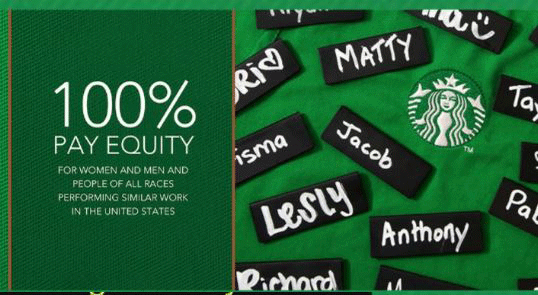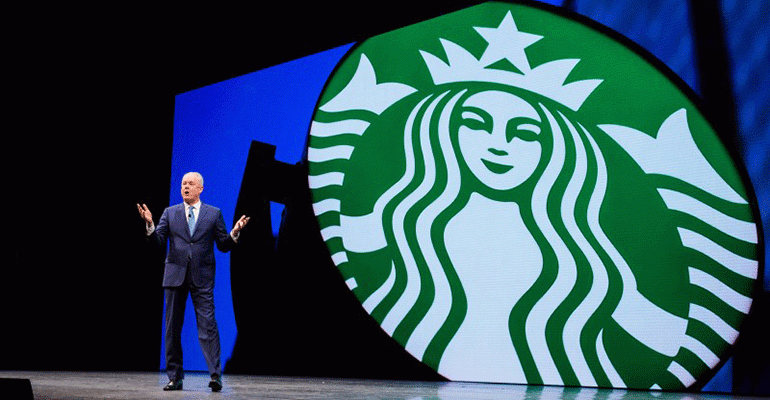To combat a seismic shift in the retail environment, Starbucks said its plans to expand digital relationships with customers, add more stores in China, and introduce premium experiences through its Reserve cafes and food program, top executives said Wednesday during the company’s 26th Annual Meeting of Shareholders.
“We’ve got to push for reinvention and innovation,” CEO Kevin Johnson said.
Johnson and Roz Brewer, COO and group president of the Seattle-based chain, outlined several initiatives to boost Starbucks revenue and shareholder value at a time when brick-and-mortar retailers are challenged by evolving consumer buying behavior.

Starbucks COO and group president Roz Brewer
Digital Push
Starbucks executives said mobile devices have become the biggest technological disruptors in the industry, and that the chain needs to pounce on consumer demand for speed and convenience.
“The growth of mobile order and pay has transformed how we run our stores,” Brewer said. “We want to serve the customers in the many ways that they want to interact with us.”
Currently, more than 30 percent of all transactions in the U.S. are paid using a mobile app, he said. Earlier this month, Starbucks said it won’t require customers to register with its loyalty card program to order and pay.
By streamlining the process, Starbucks wants to capture some 60 million U.S. customers who visit cafes each month, but are not members of the chain’s Starbucks Rewards program.
“We want to reach millions of more customers digitally,” Johnson said.
That’s especially crucial to the brand because virtually all the chain’s same-store sales growth comes from digital relationships, Starbucks CFO Scott Maw told investors in early March.
Food Innovation
Building on the success of breakfast, cold drinks and its new Blonde espresso drink, Starbucks pledged to dedicate resources to improve and expand popular menu programs.
Specifically, the company said it would double its food business by 2021.
Plans include adding more Reserve cafes and expanding its bistro box line, which has been growing at a rate of 20 percent over the past two years, the company said.
Starbucks also plans to focus on the popularity of its cold beverages.
Three years ago, cold drinks accounted for 37 percent of sales; now they make up half of all beverage sales. In 2017, cold beverage sales in the U.S. generated nearly $5 billion, Starbucks said.
This summer, Brewer said the company plans to introduce expanded flavors to its Refreshers program. The chain also will boost the availability of nitro cold brew, first introduced two years ago. It will grow from 2,300 stores in 27 countries to nearly 4,000 cafes by the end of the year.
Brewer said a multi-tap system in some stores will pour different varieties of drinks including teas, milk and coffee.
“We can now say we are the market leader in cold brew and we have more innovation than any other coffee retailer,” Brewer said.
China growth
Like many other QSR brands, Starbucks is betting big on China.
Over the last five years, Starbucks has grown from roughly 800 cafes to 3,200 in China.
“Starbucks has cracked the code in China” Johnson said.
Johnson said the brand is resonating with a fast-growing middle class in China, which has seen “explosive” GDP growth.
“We’re going to accelerate growth in China,” he said.
In December 2017, Starbucks opened its first Starbucks Reserve Roastery in Shanghai, where the chain currently operates 600 stores — the largest number of stores in any city where Starbucks operates.
The company is opening a cafe every 15 hours in China.
In other shareholder announcements, Starbucks said it plans to “return $15 billion in cash to shareholders over the next 3 years in the form of buybacks and dividends.”

The company also drew sustained applause after Lucy Helm, chief partner officer, said the company has achieved “100 percent pay equity for women and men and people of all races performing similar work across the country.”
For the first quarter ended Dec. 31, 2017, Starbucks reported a 5.9-percent increase in net revenue to $6.1 billion. Net earnings were $2.3 billion, compared with $752 million a year ago. Same-store sales rose 2 percent in the first quarter, dragged down by disappointing holiday sales.
Contact Nancy Luna at [email protected]
Follow her on Twitter: @FastFoodMaven





